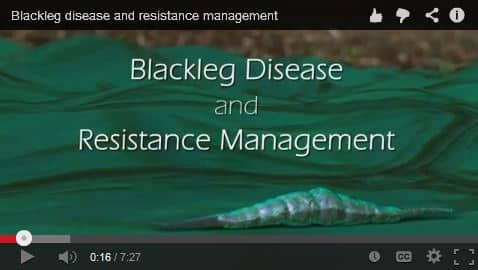A new video from the Canola Council of Canada zooms in on blackleg, showing how the canola disease infects a plant, how it spreads throughout a field, and what growers can do to protect blackleg resistance traits.
August 7, 2014– Disease surveys show an increase in blackleg incidence across the Prairies over the past few years. Canola growers may need to redeploy a more integrated approach to manage the disease.
“After 15 to 20 years of good control from resistant varieties alone, growers may have to implement other practices to protect canola yields and preserve the efficacy of genetic resistance on some fields,” says Clint Jurke, agronomy specialist for the Canola Council of Canada (CCC). “Growers and agronomists who may have forgotten what the disease looks like and how to manage it will have to rebuild their knowledge and experience base.”
The CCC launched a new video this week with vivid images to help growers understand and identify the disease. It explains how genetic resistance works, and how growing varieties with the same type of resistance in a short rotation increases the selection pressure for blackleg races that can overcome specific resistance genes.
“The video breaks new ground,” Jurke says. “It gives a microscopic view of how the pathogen produces disease, which is something we have not seen in video form before, and it explains the difficult concept of resistance breakdown.” The video, called “Blackleg Disease and Resistance Management,” is posted at www.youtube.com/canolacouncil.
Video inspires scouting
The video arms growers and agronomists with the understanding of the blackleg disease cycle and encourages them to assess the level of blackleg in this year’s canola crop. Pre-harvest scouting is an important step as growers need to be vigilant to ensure the disease is not becoming established in the field and if it is present, whether it is increasing in severity.
“This is the easiest time of year to identify the disease,” Jurke says. “By checking the average severity in a field, growers can determine whether their current management is working or whether they need to up their game.”
To scout, visit canola fields in the week or two before swathing or straight cutting. Pull up a few random plants and clip the stem just below ground level. Look for black discolouration of the cross section. A rating of “0” means no blackleg stem discolouration. A rating of “5” means the stem is completely discoloured and blackleg has killed the plant. A wedge of black that covers 26-50 percent of the cross section is considered a “2” on the severity scale.
Repeat this at a few sites within the field. If average severity is 1.5 or more, blackleg races in that field are likely starting to overcome the genetic resistance in that particular variety. Rotating varieties to bring a mix of blackleg resistance genes to the field over time can help prevent or delay the breakdown of resistance.
For more scouting tips, watch the CCC’s “Pre-Harvest Disease Scouting” video at www.youtube.com/canolacouncil.
A key component of integrated pest management (IPM) of blackleg is to combine agronomic best practices and stewardship of blackleg resistance, if the disease is present in the field. “A two- to three-year break from canola on a high-risk field along with genetic resistance is recommended,” says Ralph Lange, plant pathologist with Alberta Innovates. “In that time, most of the infected canola residue will have decomposed, reducing the spores available to infect the next canola crop.”
Controlling volunteer canola and other Brassica weeds in all crops in the rotation will also prevent blackleg buildup, Lange adds.
Applying fungicides could also help — although research is ongoing to determine the best methods. Agriculture and Agri-Food Canada found no benefit to tillage or burning stubble for blackleg management.
The Canola Council of Canada is a full value chain organization representing canola growers, value added processors, life science companies and exporters.
-30-
For more information, media can contact Canola Council of Canada agronomy specialist Clint Jurke or a CCC agronomy specialist in your region:
Clint Jurke, Western Saskatchewan
306-821-2935
OR
Angela Brackenreed, Manitoba
brackenreeda@canolacouncil.org
204-720-6923
Warren Ward, Eastern Saskatchewan
306-621-0630
Shawn Senko, Northern Saskatchewan
306-270-9307
Autumn Barnes, Southern Alberta,
587-425-0999
Keith Gabert, Central Alberta South
587-377-0557
Dan Orchard, Central Alberta North
780-777-9923
Gregory Sekulic, Peace Region of Alberta and B.C.
780-832-2382
This media release is supported regionally by:
Alberta Canola Producers Commission; SaskCanola; Manitoba Canola Growers Association; Canola Council of Canada; B.C. Grain Producers Association.
